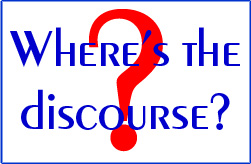Desert Dichotomy
Will It Be Force … or Discourse?
by Randall Amster
In that fateful supermarket parking lot in Tucson, two drastically different forms of politics were on display, and the contrast couldn’t have been more starkly evident. On the one hand there were ordinary people meeting with their congressional  representative, ostensibly to get to know one another and share concerns about important issues. On the other there was an alienated and disturbed individual armed with a deadly weapon, seemingly bent on making a statement of his own while brutally silencing others in the process. The fact that this transpired in beleaguered Arizona, known widely for its invidious policies, lax gun laws, and blunt politics, has served to heighten the contrast and arouse the nation’s conscience in the process.
representative, ostensibly to get to know one another and share concerns about important issues. On the other there was an alienated and disturbed individual armed with a deadly weapon, seemingly bent on making a statement of his own while brutally silencing others in the process. The fact that this transpired in beleaguered Arizona, known widely for its invidious policies, lax gun laws, and blunt politics, has served to heighten the contrast and arouse the nation’s conscience in the process.
With the Tucson massacre, we witnessed in microcosm the two dominant forms of our contemporary politics: discourse, and force. One of the reasons for the immediate pushback against the incendiary rhetoric used by certain influential figures is that it blurs the line between the two forms, conflating a central tenet of democracy with the disfavored impetus to use violence and, in so doing, inviting greater resort to the latter.
For many, there remains a profound sense that we have “peaceful revolutions†in America by virtue of our democratic processes and aren’t plagued by the overt political violence oftentimes on display elsewhere. The impact of vitriol as a tool of politicking has given us pause to consider if this is indeed so, and likewise to explore the prospect of a potentially short path from shouting to shooting. Indeed, it might be said that we’ve moved from a worldview that prioritizes First Amendment strategies to one that increasingly seems to be fixated on “Second Amendment remedies.â€
If we take a slightly broader view, however, it isn’t just rhetorical belligerence that has come to dominate the landscape in recent times. In Arizona in particular, though certainly not exclusively, the use of “force” hasn’t merely been of the verbal variety. Through various legislative attempts to reinforce an ethnic caste system, austerity measures aimed at decimating the state’s public infrastructure, the evisceration of life-saving healthcare programs, and the intentional adoption of “attrition through enforcement” policies designed to displace certain segments of the population, Arizona has coupled vitriolic political discourse with the tangible control of bodies, livelihoods, movements, and even existence itself. Largely unreported in this context have been the attendant “hate crimes†across the state, as well as a culture of intimidation that includes lawmakers carrying firearms in session. In this case, the use of force includes both the inherent power of words and the legislative power of the state, fostering a climate of alienation and antipathy that can (and does) have tragic consequences.
On the national and international levels, the news isn’t much more encouraging. U.S. foreign policy has by now devolved primarily upon the deployment of brute strength to secure resources and advance the national interests. The machinations revealed by WikiLeaks further indicate the widespread use of “soft force” tactics of subterfuge, infiltration, and potential blackmail as tools of “diplomacy.” Internally, the burgeoning emplacement of surveillance technologies and the blithe acceptance of even physically intrusive forms of unwarranted search and seizure have emerged as the leading edge of domestic social control. On a daily basis in America, the structural violence of homelessness, poverty, racism, and more continues to proliferate. Youth are everywhere bombarded with violent imagery, and the schools look more and more like pipelines to prison or proving grounds for military recruitment. In essence, we have realized the rapid onset of a culture that embodies the combined impact of rhetorical and soft force with the tangible, pervasive deployment of the technologies of war and control.
An evenhanded assessment of this culture indicates that the use of force in both words and deeds is not limited to one side of the political spectrum. While one faction may come off more crassly in its “reload†rhetoric and “shock and awe†syllogisms, it’s equally true that the pro-war perspective is plied by both major parties, and that the cultivation of cultural violence for purposes of social control and economic advantage are likewise fairly well distributed across the political spectrum. Thus, while the President may give a sincere and moving speech in Tucson, he will also promptly return to condoning drone strikes and militarizing our borders, just to name a few of the myriad ways in which force and governance regularly correlate. As Martin Luther King, Jr. noted in denouncing the war in Vietnam, “I could never again raise my voice against the violence of the oppressed in the ghettos without having first spoken clearly to the greatest purveyor of violence in the world today — my own government.â€
The use of force, both subtle and overt, is in many ways the political rule, whereas the practice of democratic discourse has become the exception. Our cultural appurtenances feed back into this narrative by constructing the “bring it on” ethos as strong-willed, bold, and part of the hero’s stock-in-trade. Discursive displays of reasonableness, outreach, and a willingness to seek understanding are coded as forms of weakness, naivete, and even appeasement. Exhortations to “reload,” “grab a torch,” and “take out” one’s adversaries tap into this sensibility, as does the invocation of graphics placing targets and bulls-eyes on those with whom we disagree. This may be symbolic in most cases, but as we’ve surmised from the Tucson massacre, it can contribute to a climate in which horrific actions occur. Words and images do have an impact on behavior — after all, the entire advertising industry is based on this very premise, and it clearly works.
The cultural referendum on the pervasive and escalating use of vitriol in politics is essentially about which side of the line these tactics fall on: force, or discourse? Is it a legitimate exercise of free speech, or does it cross over into an unacceptable form of hate-baiting that suggests at least moral if not legal culpability? The question seems to turn on whether such incendiary rhetoric is part of what a vibrant democracy must accommodate, or whether it more properly belongs in the camp of violence that we claim to disavow. The danger of calling it out as the latter is that partisan expediency can serve to cloud the fact that vitriol (and its cousins propaganda, manipulation, and fear-mongering) is an equal opportunity political tactic.
 As such, while the dichotomy of force/discourse is largely false, as most dichotomies are, it certainly feels real in the aftermath of Tucson. Culturally and politically, we have so conflated discourse and violence in America that the difference is no longer readily apparent. The Tucson shootings were uniquely characterized by a scenario that presented us, starkly and graphically, with the two extremes of our current political landscape, namely the dialogical display of democracy versus the deafening silence of brute force. Malcolm X once spoke of America’s dilemma as turning upon “the ballot or the bullet,” and there remains an instructive resonance to his words a half century later as we struggle to navigate this fine line.
As such, while the dichotomy of force/discourse is largely false, as most dichotomies are, it certainly feels real in the aftermath of Tucson. Culturally and politically, we have so conflated discourse and violence in America that the difference is no longer readily apparent. The Tucson shootings were uniquely characterized by a scenario that presented us, starkly and graphically, with the two extremes of our current political landscape, namely the dialogical display of democracy versus the deafening silence of brute force. Malcolm X once spoke of America’s dilemma as turning upon “the ballot or the bullet,” and there remains an instructive resonance to his words a half century later as we struggle to navigate this fine line.
The condemnation of vitriolic rhetoric perhaps is a starting point for a deeper engagement with these issues. But if we stop there, and mistakenly politicize the matter by making it solely the province of one party or another, we will have missed the larger point and in the process squandered yet another opportunity to promote sanity in the wake of tragedy. To do justice to the victims in Tucson and, increasingly, across America, we must revisit the ways in which force and violence are condoned at all levels of our politics and governance. This reexamination will be difficult, and will in the process call into question much of the societal architecture that has become normalized in our post-9/11 world. However, if we fail to undertake it, the resultant escalation is likely to be even more painful, as we cascade from one calamity to another.
It is not a mere coincidence that our latest national tragedy has occurred in Arizona. The state has been openly courting catastrophe for some time now, both through incendiary rhetoric and overtly divisive social policies. Perhaps the recent tragedy will someday be remembered as the turning point at which we consciously rejected the politics of “bait and hate,” and replaced it instead with a new national ethos grounded in respect and mutuality. Civil discourse may be a laudable aim, but if it is accompanied by inhumane policies then it will merely serve to stifle resistance to an inherently violent status quo. Tucson provides us with a compelling impetus to step back from the brink and embrace a form of politics that is less adversarial, and to establish peaceful concourse as the cultural norm both in terms of the rhetoric we employ and the policies we enact. The fact that this may seem far-fetched doesn’t make it any less necessary.
The desert is often known as a place of solitude, but in meeting the challenges before us, it might equally be said that we’re all in this together. We can continue to let force and violence (in all of its forms) guide us, or we can look to the virtues of measured, meaningful discourse as a potential alternative. Recent events squarely frame the choice, and we are called to respond.
Randall Amster, J.D., Ph.D., teaches Peace Studies at Prescott College, and is the Executive Director of the Peace & Justice Studies Association. His most recent book is Lost in Space: The Criminalization, Globalization, and Urban Ecology of Homelessness (LFB Scholarly, 2008), and he serves as Contributing Editor for New Clear Vision.

Desert Dichotomy: Force, or Discourse? http://t.co/lkU2YiP
1Now appearing on Truthout today as well: http://www.truth-out.org/randall-amster-will-it-be-force-or-discourse66973
2Desert Dichotomy http://t.co/N5NXePE
3Over on Dissident Voice, too: http://dissidentvoice.org/2011/01/desert-dichotomy-will-it-be-force-or-discourse/
4